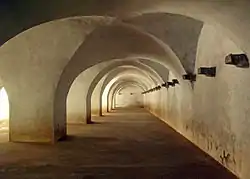Srirangapatna Fort
Srirangapatna Fort is a historical fort located in Srirangapatna, the historical capital city in the South Indian state of Karnataka. Built by the Timmanna Nayaka in 1454. The fort was fully fortified and the architecture was modified with the help of French architects to meet the growing needs of saving against invaders. The river Kaveri surrounds the fort in one of the sides. The fort is protected in the West and Northern directions by river Cauvery. The fort had Lal Mahal and Tipu's palace, which were demolished during the British capture of 1799. There are seven outlets and two dungeons.
| Srirangapatna Fort | |
|---|---|
| Part of Karnataka | |
| Srirangapatna, Karnataka, India | |
 | |
 Srirangapatna Fort | |
| Coordinates | 12.425°N 76.676°E |
| Type | Forts |
| Site information | |
| Controlled by | Bangalore Circle of the Archaeological Survey of India |
Colonel Bailey's Dungeon, Daria Daulat Bagh, Gumbaj containing tomb of Tipu Sultan, Juma Masjid (Masjid-E-Ala), Obelisk monuments and Fort walls near the breach, spot where Tipu's Body was found, Sri Kanthirava statue in Narasimha Temple, Sri Ranganatha Svami Temple and Thomas Inman's Dungeon are maintained as protected monuments under the Bangalore Circle of the Archaeological Survey of India.
History

The fort is believed to have been built by Timmanna Nayaka, a ruler of Vijayanagar Empire in 1454 CE. The fort was in the hands of the Empire till 1495 when the Wodeyars overpowered the Vijayanagar rulers. The fort was subsequently changing hands between Nawab of Arcot, Peshwas and the Marathas.[1] The Wodeyars moved their capital from Mysore to Srirangapatna and established the fort as the seat of the empire. The region and the fort made progressive changes during the rule of Chikka Devaraja Wodeyar during the years 1673 to 1704, but the three subsequent rulers had no impact. During the rule of Krishnaraja Wodeyar (1734–66), the kingdom became a strong military force and came under the control of the military general Hyder Ali.[2] Hyder Ali, had to cede the fort to the invading Marathas for 32 lakh rupees during 1757, but he came back strongly to gain it back. During 1782, Tipu Sultan, the son of Hyder Ali took the reign of the fort and built fortifications. Tipu was invaded many times by the British forces. Tipu had agreements with the French and even had letters sent to Napoleon. After several unsuccessful attempts, British forces under the command of Colonel Arthur Wellesley, 1st Duke of Wellington, made an attack on 4 May 1799 under the covers. The forces had 2,494 British soldiers and 1,882 Indian troops. The soldiers were asked to wait in trenches and started the advancement across the river during the mid day when the watchmen of the fort used to rest. The account of the offensive is found in the accounts of Colonel Beatson.[2] Tipu was killed in the battle and the English had a treaty with the Wodeyar queen.[1][3] Lord Mornington commanded the forces and the battle is considered one of the turning point in the colonization strategy of the East Indian Company.[4]
Architecture
The fort is protected in the West and Northern directions by river Cauvery. The fort had Lal Mahal and Tipu's palace, which were demolished during the British capture of 1799. There are seven outlets and two dungeons.[5] The Ranganathaswamy Temple, located inside the fort is believed to have been built by Ramanuja, the proponent of Vaishnadvaita philosophy with the grants from Dwarasamudra, the 12th century Hoysala king.[6] There temple is one of the few Hindu temples, whose towers were not destroyed by Tipu Sultan. The temple is found in the open grounds on the western side of the fort. The other temple, the Narasimhaswamy temple, is located on the other side of the open ground. The northern part of the fort houses the dungeons, where European prisoners are believed to have been confined. Tipu Sultan's palace is located opposite to the main entrance of the Ranganathaswami temple.[6] Juma mosque, built by Tipu in Indo-Islamic architecture is one of the major mosques inside the fort.[7]

Legacy
The sword and the ring of Tipu Sultan are maintained in the British Museum and believed to have been taken at the battle by Hon. Arthur Henry Cole, son of the Earl of Enniskillen.[4] Colonel Bailey's Dungeon, Daria Daulat Bagh, Gumbaj containing tomb of Tipu Sultan, Juma Masjid (Masjid-E-Ala), Obelisk monuments and Fort walls near the breach, spot where Tipu's Body was found, Sri Kanthirava statue in Narasimha Temple, Sri Ranganatha Svami Temple and Thomas Inman's Dungeon are maintained as protected monuments under the Bangalore Circle of the Archaeological Survey of India.[8]
Image Gallery
 Armory
Armory Bathing Ghat
Bathing Ghat
Notes
- Verma, Amrit. Forts of India. New Delhi: The Director, Publication Division, Ministry of Information and Broadcasting, Government of India. pp. 91–93. ISBN 81-230-1002-8.
- Tovey, Winifred. Cor Blimey! Where 'Ave You Come From?. M-Y Books Distribution. pp. 29–32. ISBN 9780956535948.
- Sampath, Vikram. Splendours of Royal Mysore. Rupa Publications. p. 54. ISBN 9788129115355.
- "Ring and sword of Tipu Sultan". British Museum. Retrieved 24 June 2015.
- Dr. K., Puttaraju. Progress of tourism in Mandya District – problems & prospects. p. 18. ISBN 9781304731708.
- Thompson 1990, p. 2
- "Srirangapatna". Mandya district administration. Retrieved 3 December 2016.
- "Alphabetical List of Monuments - Karnataka -Bangalore, Bangalore Circle, Karnataka". Archaeological Survey of India, Government of India. Indira Gandhi National Center for the Arts. Retrieved 21 December 2013.
References
- Thompson, Rev. E. W. (1990) [1923]. The last siege of Seringapatam. Mysore City: Wesleyan Mission. ISBN 8120606027.
External links
| Wikimedia Commons has media related to Srirangapatna Fort. |

